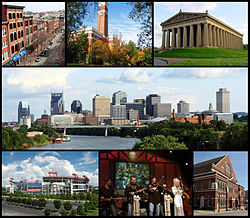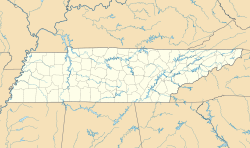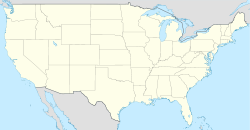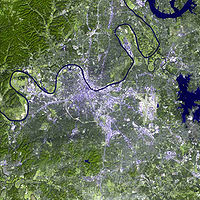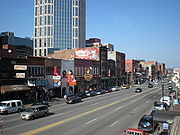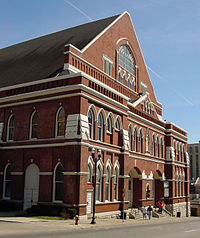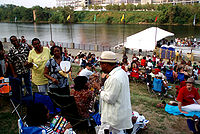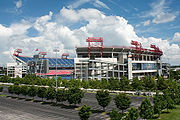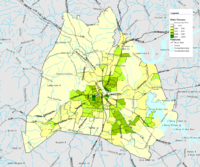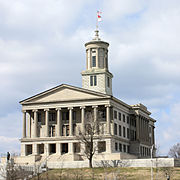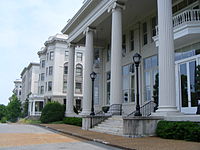
Nashville, Tennessee
Did you know...
This content from Wikipedia has been selected by SOS Children for suitability in schools around the world. Visit the SOS Children website at http://www.soschildren.org/
| Nashville | |||
|---|---|---|---|
| — Consolidated city–county — | |||
| From top left: 2nd Avenue, Kirkland Hall at Vanderbilt University, the Parthenon, the Nashville skyline, LP Field, Dolly Parton performing at the Grand Ole Opry, and Ryman Auditorium | |||
|
|||
| Nickname(s): Music City, Athens of the South | |||
|
|
|||
|
|
|||
| Coordinates: 36°10′00″N 86°47′00″W | |||
| Country | United States | ||
| State | Tennessee | ||
| County | Davidson | ||
| Founded | 1779 | ||
| Incorporated | 1806 | ||
| Government | |||
| • Mayor | Karl Dean ( D) | ||
| Area | |||
| • Consolidated city–county | 526.1 sq mi (1,362.5 km2) | ||
| • Land | 502.2 sq mi (1,300.8 km2) | ||
| • Water | 23.9 sq mi (61.8 km2) | ||
| Elevation | 597 ft (182 m) | ||
| Population (2009) | |||
| • Consolidated city–county | 635,710 | ||
| • Density | 1,233.8/sq mi (476.3/km2) | ||
| • Metro | 1,666,566 | ||
| • Balance | 605,473 | ||
| Time zone | CST ( UTC-6) | ||
| • Summer ( DST) | CDT ( UTC-5) | ||
| ZIP codes | 37201–37250 | ||
| Area code(s) | 615 | ||
| Interstates | I-40, I-24, I-65, and I-440 | ||
| Waterways | Cumberland River | ||
| Airports | Nashville International Airport | ||
| Public transit | Nashville MTA | ||
| Regional rail | Music City Star | ||
| Website | www.nashville.gov | ||
Nashville is the capital of the U.S. state of Tennessee and the county seat of Davidson County. It is located on the Cumberland River in Davidson County, in the north-central part of the state. The city is a centre for the health care, music, publishing, banking and transportation industries, and is home to a large number of colleges and universities. Nashville is the home of the Country Music genre and is dubbed "Music City".
Nashville has a consolidated city-county government which includes seven smaller municipalities in a two-tier system. The population of Nashville-Davidson County stood at 635,710 as of 2009, according to United States Census Bureau estimates. This makes it the second most populous city in the state after Memphis. However, the 2009 population of the entire 13-county Nashville Metropolitan Statistical Area was 1,582,264, making it the largest metropolitan area in the state. The 2009 population of the Nashville-Davidson–Murfreesboro–Columbia combined statistical area was estimated at 1,666,566.
History
Nashville was founded by James Robertson, John Donelson, and a party of Wataugans in 1779, and was originally called Fort Nashborough, after the American Revolutionary War hero Francis Nash. Nashville quickly grew because of its prime location, accessibility as a river port, and its later status as a major railroad centre. In 1806, Nashville was incorporated as a city and became the county seat of Davidson County, Tennessee. In 1843, the city was named the permanent capital of the state of Tennessee.

By 1860, when the first rumblings of secession began to be heard across the South, antebellum Nashville was a very prosperous city. The city's significance as a shipping port made it a desirable prize as a means of controlling important river and railroad transportation routes. In February 1862, Nashville became the first state capital to fall to Union troops. The Battle of Nashville (December 15–16, 1864) was a significant Union victory and perhaps the most decisive tactical victory gained by either side in the war.
Though the Civil War left Nashville in dire economic straits, the city quickly rebounded. Within a few years, the city had reclaimed its important shipping and trading position and also developed a solid manufacturing base. The post-Civil War years of the late 19th century brought a newfound prosperity to Nashville. These healthy economic times left the city with a legacy of grand classical-style buildings, which can still be seen around the downtown area.
It was the advent of the Grand Ole Opry in 1925, combined with an already thriving publishing industry, that positioned it to become "Music City USA"., and in the early 1960s the city was home to the main activity of the 1960s Civil Rights Movement (see History of Nashville, Tennessee). In 1963, Nashville consolidated its government with Davidson County and thus became the first major city in the United States to form a metropolitan government. Since the 1970s, the city has experienced tremendous growth, particularly during the economic boom of the 1990s under the leadership of then-Mayor and later- Tennessee Governor, Phil Bredesen, who made urban renewal a priority, and fostered the construction or renovation of several city landmarks, including the Country Music Hall of Fame, the Nashville Public Library downtown, the Bridgestone Arena, and LP Field.
The Bridgestone Arena (formerly Nashville Arena, Gaylord Entertainment Center, and Sommet Centre) was built as both a large concert facility and as an enticement to lure either a National Basketball Association or National Hockey League (NHL) sports franchise. This was accomplished in 1997 when Nashville was awarded an NHL expansion team which was subsequently named the Nashville Predators. LP Field (formerly Adelphia Coliseum) was built after the National Football League's (NFL) Houston Oilers agreed to move to the city in 1995. The NFL team debuted in Nashville in 1998 at Vanderbilt Stadium, and LP Field opened in the summer of 1999. The Oilers changed their name to the Tennessee Titans and saw a season culminate in the Music City Miracle and a close Super Bowl game that came down to the last play.
Today the city along the Cumberland River is a crossroads of American culture, and one of the fastest-growing areas of the Upper South.
Geography
Topography
Nashville lies on the Cumberland River in the northwestern portion of the Nashville Basin. Nashville's topography ranges from 385 feet (117 m) above sea level at the Cumberland River to 1,160 feet (350 m) above sea level at its highest point.
According to the United States Census Bureau, the city has a total area of 526.1 square miles (1,363 km2), of which, 502.3 square miles (1,301 km2) of it is land and 23.9 square miles (62 km2) of it (4.53%) is water.
Climate
Nashville has a humid subtropical climate ( Köppen Cfa), with generally mild winters, and hot, humid summers. Monthly averages range from 36.8 °F (2.7 °C) in January to 79.1 °F (26.2 °C) in July, with a diurnal temperature variation of 17 to 23 °F (9 to 13 °C). In the winter months, snowfall does occur in Nashville but is usually not heavy. Average annual snowfall is about 9 inches (23 cm), falling mostly in January and February and occasionally March and December. The largest snow event since 2000 was on January 16, 2003, when Nashville received 7 inches (18 cm) of snow in a single storm; the largest on record was 17 inches (43 cm), received on March 17, 1892. Rainfall is typically greater in winter and spring while autumn is the driest. Spring and fall are generally pleasantly warm but prone to severe thunderstorms, which occasionally bring tornadoes — with recent major events on April 16, 1998; April 7, 2006; February 5, 2008; April 10, 2009; and May 1–2, 2010. Relative humidity in Nashville averages 83% in the mornings and 60% in the afternoons, which is considered moderate for the Southeastern United States. In recent decades, due to urban development, Nashville has developed an urban heat island (UHI); especially on cool, clear nights, temperatures are up to 10 °F (5.6 °C) warmer in the heart of the city than in rural outlying areas.
Nashville's long springs and autumns combined with a diverse array of trees and grasses can often make it uncomfortable for allergy sufferers. In 2008, Nashville was ranked as the 18th-worst spring allergy city in the U.S. by the Asthma and Allergy Foundation of America.
The coldest temperature ever recorded in Nashville was −17 °F (−27 °C) on January 21, 1985, and the highest was 107 °F (42 °C) on July 28, 1952.
| Climate data for Nashville International Airport | |||||||||||||
|---|---|---|---|---|---|---|---|---|---|---|---|---|---|
| Month | Jan | Feb | Mar | Apr | May | Jun | Jul | Aug | Sep | Oct | Nov | Dec | Year |
| Record high °F (°C) | 78 (26) |
84 (29) |
89 (32) |
91 (33) |
96 (36) |
106 (41) |
107 (42) |
106 (41) |
105 (41) |
94 (34) |
85 (29) |
79 (26) |
107 (42) |
| Average high °F (°C) | 45.6 (7.6) |
51.4 (10.8) |
60.7 (15.9) |
69.8 (21) |
77.5 (25.3) |
85.1 (29.5) |
88.7 (31.5) |
87.8 (31) |
81.5 (27.5) |
71.1 (21.7) |
59 (15) |
49.4 (9.7) |
69 (20.6) |
| Daily mean °F (°C) | 36.8 (2.7) |
41.3 (5.2) |
50.1 (10.1) |
58.5 (14.7) |
67.1 (19.5) |
75.1 (23.9) |
79.1 (26.2) |
77.9 (25.5) |
71.3 (21.8) |
59.9 (15.5) |
49.3 (9.6) |
40.5 (4.7) |
58.9 (14.9) |
| Average low °F (°C) | 27.9 (−2.3) |
31.2 (−0.4) |
39.4 (4.1) |
47.1 (8.4) |
56.7 (13.7) |
65 (18.3) |
69.5 (20.8) |
68 (20) |
61 (16.1) |
48.6 (9.2) |
39.5 (4.2) |
31.5 (−0.3) |
48.8 (9.3) |
| Record low °F (°C) | −17 (−27) |
−13 (−25) |
2 (−17) |
23 (−5) |
34 (1) |
42 (6) |
51 (11) |
47 (8) |
36 (2) |
26 (−3) |
−1 (−18) |
−10 (−23) |
−17 (−27) |
| Precipitation inches (mm) | 3.97 (100.8) |
3.69 (93.7) |
4.87 (123.7) |
3.93 (99.8) |
5.07 (128.8) |
4.08 (103.6) |
3.77 (95.8) |
3.28 (83.3) |
3.59 (91.2) |
2.87 (72.9) |
4.45 (113) |
4.54 (115.3) |
48.11 (1222) |
| Snowfall inches (cm) | 3.9 (9.9) |
3.4 (8.6) |
1.1 (2.8) |
0 (0) |
0 (0) |
0 (0) |
0 (0) |
0 (0) |
0 (0) |
0 (0) |
0.1 (0.3) |
0.5 (1.3) |
9.1 (23.1) |
| Avg. precipitation days (≥ 0.01 in) | 11.1 | 10.1 | 12.1 | 10.7 | 11.3 | 9.7 | 10 | 8.4 | 8.3 | 7.4 | 10.1 | 11 | 120.2 |
| Avg. snowy days (≥ 0.1 in) | 2.6 | 2.4 | 0.8 | 0 | 0 | 0 | 0 | 0 | 0 | 0 | 0.2 | 1 | 7.1 |
| Mean monthly sunshine hours | 139.5 | 146.9 | 192.2 | 231 | 260.4 | 279 | 279 | 263.5 | 225 | 217 | 147 | 130.2 | 2510.7 |
| Source: NOAA; Weather.com (records); Hong Kong Observatory (sunshine hours) | |||||||||||||
Cityscape
The downtown area of Nashville features a diverse assortment of entertainment, dining, cultural and architectural attractions. The Broadway and 2nd Avenue areas feature entertainment venues, night clubs and an assortment of restaurants. North of Broadway lies Nashville's central business district, Legislative Plaza, Capitol Hill and the Tennessee Bicentennial Mall. Cultural and architectural attractions can be found throughout the city.
The downtown area of Nashville is easily accessible. Three major interstate highways (I-40, I-65 and I-24) converge near the core area of downtown, and many regional cities are within a day's driving distance.
Nashville's first skyscraper, the Life & Casualty Tower, was completed in 1957 and started the construction of high rises in downtown Nashville. After the construction of the AT&T Building (commonly known to locals as the "Batman Building") in 1994, the downtown area saw little construction until the mid-2000s. Many new residential developments have been constructed or are planned for the various neighborhoods of downtown and midtown. A new high rise office building, The Pinnacle, was recently opened in 2010.
Many civic and infrastructure projects are either being planned, in progress, or recently completed. A new MTA bus hub was recently completed in downtown Nashville, as was the Music City Star pilot project. Several public parks have been constructed, such as the Public Square. Riverfront Park is scheduled to be extensively updated. The Music City Center, a convention centre project, has been approved for the downtown area and is currently under construction.
Parks and gardens
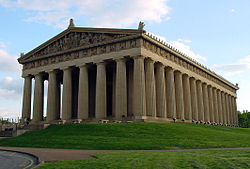
Metro Board of Parks and Recreation owns and manages 10,200 acres (4,120 ha) of land and 99 parks and greenways (comprising more than 3% of the total area of the county).
Warner Parks, situated on 2,684 acres (1,086 ha) of land, consist of a 5,000 square-foot (460 m²) learning centre, 20 miles (30 km) of scenic roads, 12 miles (19 km) of hiking trails, and 10 miles (16 km) of horse trails. It is also the home of the annual Iroquois Steeplechase.
The U.S. Army Corps of Engineers maintains parks on Old Hickory Lake and Percy Priest Lake. These parks are used for multiple activities including fishing, water-skiing, sailing and boating. Percy Priest Lake is also home to the Vanderbilt Sailing Club.
Other notable parks in Nashville include Centennial Park, Shelby Park, and Radnor Lake State Natural Area.
Metropolitan area
Nashville has the largest metropolitan area in the state of Tennessee, spanning several counties. The Nashville Metropolitan Statistical Area encompasses the Middle Tennessee counties of Cannon, Cheatham, Davidson, Dickson, Hickman, Macon, Robertson, Rutherford, Smith, Sumner, Trousdale, Williamson, and Wilson. The 2009 population of the Nashville-Davidson–Murfreesboro–Columbia combined statistical area was estimated at 1,666,566.
Culture
Much of the city's cultural life has revolved around its large university community. Particularly significant in this respect were two groups of critics and writers who were associated with Vanderbilt University in the early twentieth century: the Fugitives and the Agrarians.
Popular destinations include Fort Nashborough and Fort Negley, the former being a reconstruction of the original settlement, the latter being a semi-restored Civil War battle fort; the Tennessee State Museum; and The Parthenon, a full-scale replica of the original Parthenon in Athens. The Tennessee State Capitol is one of the oldest working state capitol buildings in the nation, while The Hermitage is one of the older presidential homes open to the public.
Entertainment and performing arts
Nashville has a vibrant music and entertainment scene spanning a variety of genres. The Tennessee Performing Arts Center is the major performing arts centre of the city. It is the home of the Tennessee Repertory Theatre, the Nashville Opera, and Nashville Ballet. In September 2006, the Schermerhorn Symphony Centre opened as the home of the Nashville Symphony Orchestra.
As the city's name itself is a metonym for the country music industry, many popular tourist sites involve country music, including the Country Music Hall of Fame and Museum, Belcourt Theatre, and Ryman Auditorium. Ryman was home to the Grand Ole Opry until 1974 when the show moved to the Grand Ole Opry House nine miles (14 km) east of downtown. The Opry plays there several times a week, except for an annual winter run at the Ryman.
Numerous music clubs and honky tonk bars can be found in downtown Nashville, especially the area encompassing Lower Broadway, Second Avenue, and Printer's Alley, which is often referred to as "the District".
Each year, the CMA Music Festival (formerly known as Fan Fair) brings thousands of country fans to the city.
Nashville was once home of television shows such as Hee Haw and Pop! Goes the Country, and to the Opryland USA theme park, which operated from 1972 to 1997 before being closed by its owners Gaylord Entertainment, and soon after demolished to make room for the Opry Mills mega-shopping mall.
The Christian pop and rock music industry is based along Nashville's Music Row, with a great influence in neighboring Williamson County. The Christian record companies include EMI Christian Music Group, Provident Label Group and Word Records.
Although Nashville was never known as a jazz town, it did have many great jazz bands, including The Nashville Jazz Machine led by Dave Converse and its current version, the Nashville Jazz Orchestra, led by Jim Williamson, as well as The Establishment, led by Billy Adair. The Francis Craig Orchestra entertained Nashvillians from 1929 to 1945 from the Oak Bar and Grille Room in the Hermitage Hotel. Craig's orchestra was also the first to broadcast over local radio station WSM-AM and enjoyed phenomenal success with a 12-year show on the NBC Radio Network. In the late 1930s, he introduced a newcomer, Dinah Shore, a local graduate of Hume Fogg High School and Vanderbilt University.
Radio station WMOT-FM in nearby Murfreesboro has aided significantly in the recent revival of the city's jazz scene, as has the non-profit Nashville Jazz Workshop, which holds concerts and classes in a renovated building in the north Nashville neighbourhood of Germantown. Fisk University also maintains a jazz station.
Nashville has an active theatre scene, having several professional and community theatre companies. Most notable of the professional theatres are Nashville Children's Theatre, Tennessee Repertory Theatre, and the Nashville Shakespeare Festival. Of the community theatres, Circle Players has been in operation for over 40 years.
Tourism
Perhaps the biggest factor in drawing visitors to Nashville is its association with country music. Many visitors to Nashville attend live performances of the Grand Ole Opry, the world's longest running live radio show. The Country Music Hall of Fame is another major attraction relating to the popularity of country music. The Opryland Hotel, the Opry Mills regional shopping mall and the General Jackson showboat, are all located in what is known as Music Valley.
Civil War history is important to the city's tourism industry. Sites pertaining to the Battle of Nashville and the nearby Battle of Franklin and Battle of Stones River can be seen, along with several well-preserved antebellum plantation houses such as Belle Meade Plantation, Carnton plantation in Franklin, and Belmont Mansion.
Nashville has several arts centers and museums, including the Frist Centre for the Visual Arts, Cheekwood Botanical Garden and Museum of Art, the Tennessee State Museum, Fisk University's Van Vechten and Aaron Douglas Galleries, Vanderbilt University's Fine Art Gallery and Sarratt Gallery, and the Parthenon. The Nashville Zoo is one of the city's newer attractions.
Major annual events
| Event | Month Held and Location |
|---|---|
| Nashville Film Festival | Weeklong festival in April. It features hundreds of independent films and is one of the biggest film festivals in the Southern United States. |
| Country Music Marathon | Marathon and half marathon which normally include over 25,000 runners from around the world in April. |
| Iroquois Steeplechase | Annual steeplechase horse racing event which takes place in May at Percy Warner Park. |
| CMA Music Festival | A four day event in June featuring performances by country music stars, autograph signings, artist/fan interaction, and other activities for country music fans. |
| Fourth of July | Celebration which takes place each year at Riverfront Park. |
| Tomato Art Festival | Takes place in East Nashville every August. |
| African Street Festival | Takes place on the campus of Tennessee State University in September. |
| Tennessee State Fair | In September at the State Fairgrounds. The State Fair lasts nine days and includes rides, exhibits, rodeos, tractor pulls, and numerous other shows and attractions. |
| Country Music Association Awards | Usually held in November at the Bridgestone Arena and televised nationally to millions of viewers. |
Sports
Professional
Nashville has many professional sports teams, most notably the Nashville Predators of the National Hockey League and the Tennessee Titans of the National Football League. Several other pro sports teams also call Nashville home, as does the NCAA college football Music City Bowl. Nashville is also home to the Music City Motorplex, a NASCAR Whelen All-American Series racetrack.
| Club | Sport | League | Venue | Established |
|---|---|---|---|---|
| Tennessee Titans | Football | National Football League | LP Field | 1960 |
| Nashville Predators | Hockey | National Hockey League | Bridgestone Arena | 1997 |
| Nashville Sounds | Baseball | Pacific Coast League | Herschel Greer Stadium | 1978 |
| Nashville Metros | Soccer | Premier Development League | Ezell Park | 1989 |
College
Nashville is also home to four Division I athletic programs.
| Program | Division | Conference | Major venues |
|---|---|---|---|
| Vanderbilt Commodores | Division I ( FBS) | Southeastern Conference | Vanderbilt Stadium (football) Memorial Gymnasium (basketball) Hawkins Field (baseball) |
| Tennessee State Tigers | Division I ( FCS) | Ohio Valley Conference | LP Field (football) Gentry Centre (basketball) |
| Belmont Bruins | Division I ( non-football) | Atlantic Sun Conference | Curb Event Centre |
| Lipscomb Bisons | Division I ( non-football) | Atlantic Sun Conference | Allen Arena |
Economy
As the "home of country music", Nashville has become a major music recording and production centre. All of the Big Four record labels, as well as numerous independent labels, have offices in Nashville, mostly in the Music Row area. Since the 1960s, Nashville has been the second biggest music production centre (after New York) in the U.S. As of 2006, Nashville's music industry is estimated to have a total economic impact of $6.4 billion per year and to contribute 19,000 jobs to the Nashville area.
Although Nashville is renowned as a music recording centre and tourist destination, its largest industry is actually health care. Nashville is home to more than 250 health care companies, including Hospital Corporation of America, the largest private operator of hospitals in the world. As of 2006, it is estimated that the health care industry contributes $18.3 billion per year and 94,000 jobs to the Nashville-area economy. The automotive industry is also becoming increasingly important for the entire Middle Tennessee region. Nissan North America moved its corporate headquarters in 2006 from Gardena, California ( Los Angeles County) to Franklin. Nissan also has its largest North American manufacturing plant in Smyrna, Tennessee. Largely as a result of the increased development of Nissan and other Japanese economic interests in the region, Japan moved its New Orleans Consulate-general to Nashville's Palmer Plaza.
Other major industries in Nashville include insurance, finance, and publishing (especially religious publishing). The city hosts headquarters operations for several Protestant denominations, including the United Methodist Church, Southern Baptist Convention, National Baptist Convention, and the National Association of Free Will Baptists.
Fortune 500 companies within Nashville include Dell, HCA Inc. (formerly, Hospital Corporation of America) and Dollar General Corporation (in Goodlettsville).
Top Employers
According to the City's 2009 Comprehensive Annual Financial Report, the top employers in the city are:
| # | Employer | # of Employees |
|---|---|---|
| 1 | Vanderbilt University and Medical Centre | 24,858 |
| 2 | State of Tennessee | 20,800 |
| 3 | Metropolitan Government of Nashville and Davidson County and Public Schools |
19,692 |
| 4 | U.S. Government | 11,271 |
| 5 | HCA | 8,700 |
| 6 | Saint Thomas Health Services | 7,200 |
| 7 | Nissan North America | 6,750 |
| 8 | Wal-Mart | 4,500 |
| 9 | Cracker Barrel Old Country Store | 4,017 |
| 10 | Shoney's | 4,000 |
Demographics
| Historical populations | |||
|---|---|---|---|
| Census | Pop. | %± | |
| 1830 | 5,566 |
|
|
| 1840 | 6,929 | 24.5% | |
| 1850 | 10,165 | 46.7% | |
| 1860 | 16,988 | 67.1% | |
| 1870 | 25,865 | 52.3% | |
| 1880 | 43,350 | 67.6% | |
| 1890 | 76,168 | 75.7% | |
| 1900 | 80,865 | 6.2% | |
| 1910 | 110,364 | 36.5% | |
| 1920 | 118,342 | 7.2% | |
| 1930 | 153,866 | 30.0% | |
| 1940 | 167,402 | 8.8% | |
| 1950 | 174,307 | 4.1% | |
| 1960 | 170,874 | −2.0% | |
| 1970 | 448,003 | 162.2% | |
| 1980 | 455,651 | 1.7% | |
| 1990 | 488,374 | 7.2% | |
| 2000 | 545,524 | 11.7% | |
| Source: U.S. Census | |||
According to the 2006–2008 American Community Survey, the racial composition of Nashville-Davidson County was as follows:
- White: 65.9% ( Non-Hispanic Whites: 60.9%)
- Black or African American: 27.1%
- Native American: 0.4%
- Asian: 3.1%
- Native Hawaiian and Other Pacific Islander: 0.1%
- Other race: 2.3%
- Two or more races: 1.2%
- Hispanic or Latino (of any race): 7.5%
The data below is for all of Metropolitan Nashville-Davidson County, including other incorporated cities within the consolidated city-county (such as Belle Meade and Berry Hill). See Nashville-Davidson (balance) for demographic data on Nashville-Davidson County excluding separately incorporated cities.
As of the census of 2000, there were 569,891 people, 237,405 households, and 138,169 families residing in the city. The population density was 1,134.6 people per square mile (438.1/km²). There were 252,977 housing units at an average density of 503.7/sq mi (194.5/km²). The racial makeup of the city was 66.99% White, 25.92% African American, 0.29% Native American, 2.33% Asian, 0.07% Pacific Islander, 2.42% from other races and 1.97% from two or more races. Hispanics or Latinos of any race were 4.58% of the population. Metropolitan Nashville-Davidson County's estimated population for 2007 is 626,144 people.
There were 237,405 households out of which 26.7% had children under the age of 18 living with them, 39.9% were married couples living together, 14.3% had a female householder with no husband present, and 41.8% were non-families. 33.4% of all households were made up of individuals and 8.2% had someone living alone who was 65 years of age or older. The average household size was 2.30 and the average family size was 2.96.
The age distribution was 22.2% under 18, 11.6% from 18 to 24, 34.0% from 25 to 44, 21.1% from 45 to 64, and 11.1% who were 65 or older. The median age was 34 years. For every 100 females there were 93.8 males. For every 100 females age 18 and over, there were 90.8 males.
The median income for a household in the city was $39,797, and the median income for a family was $49,317. Males had a median income of $33,844 versus $27,770 for females. The per capita income for the city was $23,069. About 10.0% of families and 13.0% of the population were below the poverty line, including 19.1% of those under age 18 and 10.5% of those age 65 or over.
Because of its relatively low cost of living and large job market, Nashville has become a popular city for immigrants. Nashville's foreign-born population more than tripled in size between 1990 and 2000, increasing from 12,662 to 39,596. Large groups of Mexicans, Kurds, Vietnamese, Laotians, Cambodians, Arabs, and Bantus call Nashville home, among other groups. Nashville has the largest Kurdish community in the United States, numbering approximately 11,000. About 60,000 Bhutanese refugees are being admitted to the U.S. and some of them will resettle in Nashville. During the Iraqi election of 2005, Nashville was one of the few international locations where Iraqi expatriates could vote. The American Jewish community in Nashville dates back over 150 years, and numbers about 6,500 (2001).
Law and government
The City of Nashville and Davidson County merged in 1963 as a way for Nashville to combat the problems of urban sprawl. The combined entity is officially known as "the Metropolitan Government of Nashville and Davidson County", and is popularly known as "Metro Nashville" or simply "Metro". It offers services such as police, fire, electricity, water and sewage treatment. When the Metro government was formed in 1963, the government was split into two service districts—the "urban services district" and the "general services district." The urban services district encompasses the 1963 boundaries of the former City of Nashville, and the general services district includes the remainder of Davidson County. There are seven smaller municipalities within the consolidated city-county: Belle Meade, Berry Hill, Forest Hills, Lakewood, Oak Hill, Goodlettsville (partially), and Ridgetop (partially). These municipalities use a two-tier system of government, with the smaller municipality typically providing police services and the Metro Nashville government providing most other services. In 2010, Lakewood voters passed a referendum (by one vote) to dissolve its city charter and join the metropolitan government.
Nashville is governed by a mayor, vice-mayor, and 40-member Metropolitan Council. It uses the strong-mayor form of the mayor-council system. The current mayor of Nashville is Karl Dean. The Metropolitan Council is the legislative body of government for Nashville and Davidson County. There are 5 council members who are elected at large and 35 council members that represent individual districts. The Metro Council has regular meetings that are presided over by the vice-mayor, who is currently Diane Neighbors. The Metro Council meets on the first and third Tuesday of each month at 6:00 pm, according to the Metropolitan Charter.
Politics
Nashville has been a Democratic stronghold since at least the end of Reconstruction. While local elections are officially nonpartisan, nearly all of the city's elected officials are known to be Democrats. At the state level, Democrats hold all but one of the city's state house districts and all but one of the city's state senate districts.
Democrats are no less dominant at the federal level. Over the past 100 years, Democratic presidential candidates have carried Nashville/Davidson County in 4 out of 5 elections. Normally, Democrats carry Nashville at the presidential level with relatively little difficulty. In the 2000 presidential election, Al Gore carried Nashville with over 59% of the vote even as he narrowly lost his home state. In the 2004 election, John Kerry carried Nashville with 55% of the vote even as George W. Bush won the state by 14 points. In 2008, Barack Obama carried Nashville with 60 percent of the vote even as John McCain won Tennessee by 15 points.
At the federal level, Nashville is split between two congressional districts. Nearly all of the city is in the 5th District, currently represented by Democrat Jim Cooper. A Republican has not represented a significant portion of Nashville since 1874. While Republicans made a few spirited challenges in the mid-1960s and early 1970s, they have not made a serious bid for the district since 1972, when the Republican candidate gained only 38% of the vote even as Nixon carried the district in the presidential election by a large margin. The district's best-known congressman was probably Jo Byrns, who represented the district from 1909 to 1936 and was Speaker of the House for much of Franklin Roosevelt's first term as President. Another nationally prominent congressman from Nashville was Percy Priest, who represented the district from 1941 to 1956 and was House Majority Whip from 1949 to 1953. Former mayors Richard Fulton and Bill Boner also sat in the U.S. House before assuming the Metro mayoral office.
All of Nashville was located in a single district for most of the time from Reconstruction until the 2000 Census, when a small portion of southwestern Nashville was drawn into the heavily Republican 7th District. That district is currently represented by Marsha Blackburn of neighboring Williamson County; Blackburn represented much of the Nashville share of the 7th in the state senate from 1998 to 2002.
Education
Public Schools
The city is served by the Metropolitan Nashville Public Schools.
Private Schools
- David Lipscomb Campus School
- Davidson Academy
- Donelson Christian Academy
- Ensworth School
- Ezell-Harding Christian School
- Franklin Road Academy
- Father Ryan
- Goodpasture Christian School
- Harpeth Hall School
- Madison Academy
- Montgomery Bell Academy
- Nashville Christian School
- St. Cecilia Academy
- University School of Nashville
Colleges and Universities
Nashville is often labeled the "Athens of the South" due to the many colleges and universities in the city and metropolitan area. The colleges and universities in Nashville include American Baptist College, Aquinas College, The Art Institute of Tennessee – Nashville, Belmont University, Daymar Institute, Fisk University, Free Will Baptist Bible College, Gupton College, International Academy of Design and Technology, Lipscomb University, Meharry Medical College, Nashville School of Law, Nashville Auto Diesel College (a NAFTC Training Centre), Nashville State Community College, Strayer University, Tennessee State University, Trevecca Nazarene University, University of Phoenix, Vanderbilt University, and Watkins College of Art, Design & Film.
Within 30 miles (48 km) of Nashville in Murfreesboro is Middle Tennessee State University (MTSU), a full-sized public university with Tennessee's largest undergraduate population. Enrollment in post-secondary education in Nashville is around 43,000. Within the Nashville Metropolitan Statistical Area—which includes MTSU, Cumberland University ( Lebanon), Volunteer State Community College ( Gallatin), Daymar Institute, and O'More College of Design (Franklin)—total enrollment exceeds 74,000. Within a 40 miles (64 km) radius are Austin Peay State University ( Clarksville) and Columbia State Community College ( Columbia), enrolling an additional 13,600.
Transportation
Nashville is centrally located at the crossroads of three Interstate Highways: I-40, I-24, and I-65. Interstate 440 is a bypass route connecting I-40, I-65, and I-24 south of downtown Nashville. Briley Parkway connects the north side of the city and its interstates. A number of arterial surface roads called "pikes" radiate from the city centre; many carry the names of nearby towns to which they lead. Among these are Clarksville Pike, Gallatin Pike, Lebanon Pike, Murfreesboro Pike, Nolensville Pike, and Franklin Pike.
The Metropolitan Transit Authority provides bus transit within the city, out of a newly built hub station downtown. Routes utilize a hub and spoke method. Expansion plans include use of Bus rapid transit for new routes, with the possibility for local rail service at some point in the future.
Nashville is considered a gateway city for rail and air traffic for the Piedmont Atlantic MegaRegion.
The city is served by Nashville International Airport, which was a hub for American Airlines between 1986 and 1995 and is now a mini-hub for Southwest Airlines.
Although it is a major rail hub, with a large CSX Transportation freight rail yard, Nashville is one of the largest cities in the U.S. not served by Amtrak.
Nashville launched a passenger commuter rail system called the Music City Star on September 18, 2006. The only currently operational leg of the system connects the city of Lebanon to downtown Nashville at the Nashville Riverfront. Legs to Murfreesboro and Gallatin are currently in the feasibility study stage. The system plan includes seven legs connecting Nashville to surrounding suburbs.
Notable bridges in the city are:
| Official Name | Other Names | Length | Date Opened |
|---|---|---|---|
| Gateway Bridge | Korean War Veterans Memorial Bridge | 1,660 feet (510 m) | May 19, 2004 |
| Kelly Miller Smith Bridge | Jefferson Street Bridge | March 2, 1994 | |
| Old Hickory Bridge | 1929 | ||
| Martin Luther King Jr. Bridge | Bordeaux Bridge | September 18, 1980 | |
| Shelby Street Bridge | Shelby Avenue Bridge | 3,150 feet (960 m) | July 5, 1909 |
| Silliman Evans Bridge | 2,362 feet (720 m) | 1963 | |
| Victory Memorial Bridge | July 2, 1956 | ||
| William Goodwin Bridge | Hobson Pike Bridge | 2,215 feet (675 m) | |
| Woodland Street Bridge | 639 feet (195 m) |
Nicknames
Nashville is a colorful, well-known city in several different arenas. As such, it has earned various sobriquets, including:
- Music City, USA: WSM-AM announcer David Cobb first used this name during a 1950 broadcast and it stuck. It is now the official nickname used by the Nashville Convention and Visitors Bureau. Nashville is the home of the Grand Ole Opry, the Country Music Hall of Fame, and many major record labels. This name also dates back to 1874, where after receiving and hearing a performance by the Fisk Jubilee Singers, Queen Victoria of England is reported as saying that "These young people must surely come from a musical city."
- Athens of the South: Home to twenty-four post-secondary educational institutions, Nashville has long been compared to the ancient city of learning, site of Plato's Academy. Since 1897, a full-scale replica of the Athenian Parthenon has stood in Nashville, and many examples of classical and neoclassical architecture can be found in the city.
- The Protestant Vatican or The Buckle of the Bible Belt: Nashville has over 700 churches, several seminaries, a number of Christian music companies, and is the headquarters for the publishing arms of both the Southern Baptist Convention ( LifeWay Christian Resources) and the United Methodist Church ( United Methodist Publishing House). It is also the seat of the National Baptist Convention, the National Association of Free Will Baptists, the Gideons International, the Gospel Music Association, and Thomas Nelson, the world's largest producer of Bibles.
- Cashville: Nashville native Young Buck released a very successful rap album called Straight Outta Ca$hville that has popularized the nickname among a new generation.
- Little Kurdistan: Nashville has the United States' largest population of Kurdish people, estimated to be around 11,000.
- Nash Vegas or Nashvegas
- Guitar or Guitar Town: Commonly used CB slang name.
Sister cities
Nashville is an active participant in the Sister Cities program and has relationships with the following towns:

 Belfast, Northern Ireland (United Kingdom)
Belfast, Northern Ireland (United Kingdom) Caen (France)
Caen (France) Edmonton, Alberta (Canada)
Edmonton, Alberta (Canada) Magdeburg (Germany)
Magdeburg (Germany) Mendoza (Argentina)
Mendoza (Argentina) Taiyuan, Shanxi (People's Republic of China)
Taiyuan, Shanxi (People's Republic of China) Girona (Spain) currently pending agreement – negotiation started in 2006
Girona (Spain) currently pending agreement – negotiation started in 2006
